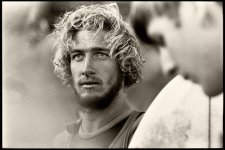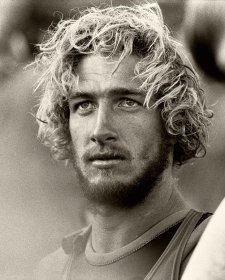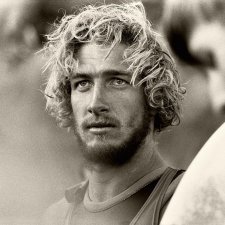- About us
- Support the Gallery
- Venue hire
- Publications
- Research library
- Organisation chart
- Employment
- Contact us
- Make a booking
- Onsite programs
- Online programs
- School visit information
- Learning resources
- Little Darlings
- Professional learning
Wayne Lynch (b. 1951), surfer, precedes Bob McTavish (b. 1944), surfboard maker, across farmland around Possum Creek, not far from Bangalow in northern New South Wales. All elements of the photograph unite to encapsulate the dream of leaving the city for a more fundamental life, connected and attuned to the natural world. John Witzig used it in a double-page spread in his last issue as editor of Surf International, Vol 2 No 7, the ‘Country Soul’ issue, in which he urged readers to abandon their socially-conditioned, State-sanctioned aspirations and come ‘share the brown rice’. The photograph inspired the National Portrait Gallery exhibition Arcadia: Sound of the sea (2014-2015). Wayne Lynch is renowned now as one of the world’s great ‘soul surfers’, not for his competition results, but for his unprecedented physical and spiritual involvement with the wave. Bob McTavish, a surfer from childhood, began work in the surfboard business in 1961 and still sells his boards worldwide. Debate still rages about the origin of what became known as the ‘shortboard revolution’ that began in Australia in the mid-1960s, but McTavish, along with his Californian friend George Greenough, was inarguably central to it.
Wayne Lynch (b. 1951), surfer, grew up in Lorne, Victoria. From the age of ten, he won six consecutive Victorian junior titles, and the Australian junior title four years running between 1967 and 1970. In 1969 he appeared in Paul Witzig’s movie Evolution and in 1971, his classic Sea of Joy. Lynch won the Sydney Surfabout contest, then the world’s richest professional event, in 1975, and was runner-up in 1978; yet he is remembered as a soulful surfer rather than an aggressive competitor. He was rated the third-best surfer of all time by Surfing magazine in 2004, and seventeenth-best of all time by Surfer magazine in 2009. Bob McTavish (b. 1944) shortboard pioneer, began surfing as a boy in Queensland, and worked for surfboard manufacturers from 1961. Having won the Queensland Open surf title in 1965, in 1966–67, inspired by the example of Californian kneeboard rider George Greenough, he began to develop a shorter surfboard that would open up new possibilities in the water, consigning ‘noseriding’ to history as the surfer was enabled to ride the wave, not the board. In 1969 he established his brand, McTavish, and in 1972 he launched the world’s first production shortboard, the Bluebird. In the 1980s, McTavish turned to materials innovation; operating from a factory and retail base in Byron Bay, he sells his boards all over the world. John Witzig (b. 1944), photographer, writer and designer, contributed his first piece to Surfing World in 1963. From 1967 to 1969 he was editor of Surf International. He took this picture of his friends in the hills behind Byron Bay as he was putting together his final issue of Surf International – the ‘Country Soul’ number. Like many of Witzig’s era-defining shots, he says ‘it got taken simply because I carried my camera around a lot’. In 1970 Witzig co-founded Tracks magazine, which is now acknowledged as ‘maybe the hippest youth culture magazine being published anywhere in the world at the time’. The American arthouse imprint, Rizzoli, released the definitive retrospective volume of Witzig’s photographs in 2013.
Gift of the artist 2011
© John Witzig
John Witzig (age 25 in 1969)
Wayne Lynch (age 18 in 1969)
Bob McTavish (age 25 in 1969)
John Witzig (3 portraits)



On one level The Companion talks about the most famous and frontline Australians, but on another it tells us about ourselves.



An exhibition of photographs by John Witzig, drawings by Nicholas Harding and film footage by Albe Falzon, expressive of the free-spirited, hot-blooded energy of Australian surfers under the cloud of conscription to Vietnam.



Visit us, learn with us, support us or work with us! Here’s a range of information about planning your visit, our history and more!